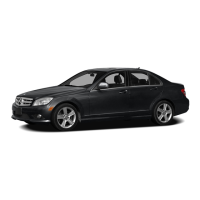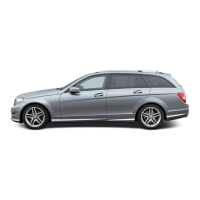Do you have a question about the Mercedes-Benz C-Class and is the answer not in the manual?
Covers warranty terms, conditions, and replacement parts.
Details the Roadside Assistance Program for breakdown help and hotline numbers.
Emphasizes risks of unauthorized repairs, modifications, or improper operation.
Defines authorized Mercedes-Benz Centers as qualified workshops for necessary work.
Urges contacting an authorized center for operational issues and provides contact addresses.
Explains recording of diagnostic info, operation, malfunctions, and user settings.
Explains EDR purpose to record data in crash situations for analysis.
Details the displays within the instrument cluster, including speedometer and tachometer.
Explains the functions and controls on the steering wheel for various systems.
Describes the upper and lower sections of the center console and their controls.
Explains how the restraint system reduces occupant injury in accidents.
Describes the restraint system warning lamp and conditions indicating a malfunction.
Explains the function of ON/OFF lamps related to the front-passenger air bag.
Discusses front-passenger airbag interaction with child restraints based on OCS.
Explains how front-passenger airbag is enabled/disabled based on occupant classification.
Discusses seat belt condition and modification warnings.
Detailed instructions on how to fasten and adjust seat belts correctly.
Explains the seat belt warning lamp and tone function as a reminder to fasten belts.
Introduction to air bag symbols, function as a supplement to seat belts, and deployment limitations.
Describes the deployment areas of front and passenger airbags and their protective function.
Explains the driver's knee airbag location and its protective function for thigh, knee, and lower leg.
Warns about seat covers affecting airbag deployment and describes side impact protection.
Details window curtain airbag integration, deployment area, and head protection.
Explains how OCS categorizes front-passenger occupants to enable/disable airbags.
Lists problems, causes, consequences, and solutions related to the OCS.
Warns about hot parts after deployment and the need for replacement.
Explains PRE-SAFE® measures to protect occupants in hazardous situations.
Describes how PRE-SAFE® intervenes in emergency braking and critical driving situations.
Details PRE-SAFE® PLUS for detecting imminent head-on/rear-end collisions.
Lists immediate post-accident measures like hazard lights and door unlocking.
Details legal requirements for seat belts and child restraint systems.
Explains how to activate/deactivate child-proof locks for doors and windows.
Advises on installing rearward-facing restraints on front-passenger seat with airbag disabled.
Instructions for installing forward-facing restraints, including seat and belt routing.
Explains the LATCH-type system for child seats and its installation.
Recommends rear seats for child restraints and notes on OCS for front-passenger installation.
Explains how ABS regulates brake pressure to prevent wheel lock-up during braking.
Explains BAS operation in emergency braking to automatically boost braking force.
Instructs to keep brake pedal depressed until emergency situation is over, noting ABS prevents wheel lock.
Explains BAS PLUS requirements (radar/camera systems) and detection capabilities.
Explains COLLISION PREVENTION ASSIST PLUS as distance warning, emergency braking, and adaptive brake assist.
Explains COLLISION PREVENTION ASSIST PLUS as distance warning, emergency braking, and adaptive brake assist.
Warns about limitations of distance warning, especially with pedestrians or crossing traffic.
Explains how Adaptive Brake Assist enhances safety and comfort, including HOLD and hill start assist.
Explains ESP® monitors stability, traction, and uses braking/engine output to stabilize the vehicle.
Describes how the ECO start/stop function switches the engine off when stopped.
Explains how to deactivate/activate ESP® via the on-board computer.
Explains how Crosswind Assist reduces effects of strong crosswinds by automatic braking.
Notes PRE-SAFE® Brake availability with Driving Assistance package and its sensor requirements.
Details PRE-SAFE® Brake's automatic braking and warning functions based on detected collision risks.
Explains STEER CONTROL transmits steering force for vehicle stabilization, especially on slippery surfaces.
Explains STEER CONTROL transmits steering force for vehicle stabilization, especially on slippery surfaces.
Explains the immobilizer prevents starting without the correct SmartKey.
Details the functions of the SmartKey, including locking, unlocking, and trunk lid operation.
Explains central locking/unlocking using KEYLESS-GO and the SmartKey.
Describes using the mechanical key if SmartKey/KEYLESS-GO fails and potential anti-theft alarm activation.
Warns about toxic battery contents and the need to keep them away from children.
Instructions on how to check the SmartKey battery and indications of discharge.
Details the type of battery needed and steps for replacement.
Lists common SmartKey issues like battery discharge or interference, with solutions.
Instructions for opening front and rear doors from inside, noting alarm activation.
Explains how to centrally lock/unlock the vehicle using switches on the driver's door.
Instructions for using the mechanical key to unlock the driver's door if SmartKey/KEYLESS-GO fails.
Instructions for locking the vehicle using the mechanical key when SmartKey/KEYLESS-GO fails.
Describes how to manually open and close the trunk lid.
Details automatic trunk opening/closing with SmartKey or HANDS-FREE ACCESS.
Instructions for opening the trunk lid automatically from the driver's seat.
Instructions for closing the trunk lid, including automatic closing with KEYLESS-GO.
Instructions for using the mechanical key to unlock the trunk if other methods fail.
Describes how to unlock the trunk lid from inside using the emergency release button.
Details operation of all side windows using driver's door switches and individual door switches.
Provides warnings and instructions for adjusting the driver's seat, head restraint, and mirrors.
Important safety notes regarding seat adjustment, occupant trapping, and proper seat belt use.
Warns about children trapping, seat disengagement, and proper head restraint adjustment.
Details manual and electrical seat adjustment, including memory functions.
Important safety notes and warnings about adjusting the steering wheel while driving or by children.
Step-by-step instructions for manually adjusting steering wheel height and position.
Important safety notes and warnings about the EASY-ENTRY/EXIT feature trapping body parts.
General notes on how the system automatically adapts headlamp range and recognizes road users.
Important safety notes about hot bulbs and proper replacement procedures.
Important safety notes about changing wiper blades and avoiding damage.
Details controls for temperature, air distribution, airflow, and defrosting functions.
Details front and rear control panels for 3-zone automatic climate control functions.
Important safety notes about hot/cold air from vents and maintaining distance.
Important safety notes regarding sensor system adjustment and brake pad bedding-in.
Important safety notes about objects in footwell, footwear, and switching off ignition while driving.
Warnings and instructions for engaging transmission positions D or R and releasing parking brake.
Important safety notes on engaging transmission positions and risks of vehicle rolling away.
Provides warnings about shifting to neutral N while driving and potential damage.
Important safety notes on fuel flammability and toxicity, and correct refueling procedures.
Information on Mercedes-Benz Intelligent Drive, driver assistance, and safety systems.
Important safety notes on flammable materials near hot parts and risks of switching ignition off while driving.
Important safety notes on automatic transmission shifting to N and risks of vehicle rolling away.
Warns about poisonous exhaust gases and the risk of fatal injury from engine running in enclosed spaces.
Warns about the dangers of drinking/drug use while driving and the increased risk of accidents.
Important safety notes on slippery roads, downhill gradients, and heavy/light loads.
Information on Mercedes-Benz Intelligent Drive, driver assistance, and safety systems.
Overview of driver assistance and safety systems enhancing comfort and support.
General notes on cruise control maintaining constant speed and automatic braking.
General notes on DISTRONIC PLUS regulating speed and maintaining distance using radar sensors.
Details activation conditions for DISTRONIC PLUS, including engine start and system requirements.
Warns about vehicle rolling away if DISTRONIC PLUS or HOLD malfunction.
Details various ways to deactivate DISTRONIC PLUS and its automatic deactivation conditions.
Lists conditions required for HOLD function activation (vehicle stationary, engine running, etc.).
Important safety notes on PARKTRONIC as an electronic parking aid with ultrasonic sensors.
Lists display messages related to safety systems and their possible causes/solutions.
Lists display messages related to safety systems and their possible causes/solutions.
Lists EBD unavailability due to malfunction and related warning lamps.
Warns about low brake fluid level, potential braking impairment, and risks.
Indicates restraint system fault and potential unintended airbag deployment or failure.
Warns about low coolant level, potential engine damage, and recommends checking level and adding coolant.
Warns about overheated engine, risks of fire/burns, and advises stopping vehicle safely.
Indicates battery charge level is too low and warns about potential engine overheating.
Warns about critically low engine oil level, advising to stop vehicle safely and check oil.
Warns that course-correcting brake application cannot always prevent collision.
Important safety notes regarding hazards in the engine compartment.
Important safety notes for opening and closing the hood, including moving parts.
Warns about hot engine components and ignition risks when adding oil.
Warns about damage from jet nozzles, acidic cleaners, and risks of parking after cleaning.
Warns about body parts trapping by wipers and risks of damaging windows with hard objects.
Warns about body parts trapping by wipers and risks of damaging blades.
Details risks of underinflated (burst, wear, handling) and overinflated (burst, wear, comfort) tires.
Important safety notes on checking tire pressure and the risks of incorrect pressure.
Instruction labels for tires and loads, including warnings about overloaded tires.
Overview of tire markings including DOT, size designation, load, and speed rating.
Warns about risks of exceeding tire load capacity and approved maximum speed.
Warns about impairing driving characteristics if wheels/tires have different dimensions.
Warns about incorrect jack positioning and risks of injury.
General notes on using approved tire types, sizes, and load/speed ratings.
General notes on using approved tire types, sizes, and load/speed ratings.
Warns about risks of damage and accidents when installing snow chains on front wheels.
Important safety notes on tire pressure and tread depth.
Warns about risks of under/overinflated tires and how to check pressure.
Preparing the vehicle for a flat tire situation and warnings.
Steps to prepare the vehicle for a flat tire, including stopping safely and securing it.
Important safety notes on TIREFIT sealant, its limitations, and handling precautions.
Important safety notes regarding battery work, risks of short circuits, and electrostatic build-up.
Warns about explosive gases during charging/jump-starting and caustic battery acid.
Provides important safety notes on jump-starting procedures and battery handling risks.
Important safety notes regarding vehicle safety functions when towing.
Important safety notes about manipulating fuses and replacing them with correct amperage.
Loading guidelines warning about exhaust gases, unsecured loads, and hot exhaust parts.
Warns about exhaust gases, unsecured loads, hot exhaust parts, and handling characteristics with loads.
Important safety notes on correctly storing objects to prevent them from slipping or being flung.
Important safety notes on skibag use, securing objects, and transport limitations.
Important safety notes about engaging seat backrests to prevent folding forwards.
Warns that bag hooks cannot restrain heavy objects and risks of injury.
Important safety notes about hands trapping and damage to the EASY-PACK trunk box.
Important safety notes on vehicle center of gravity change and roof load.
Warns about guiding roller sunblind by hand and avoiding damage to mechanism.
Describes self-test procedure and indicates malfunctions via indicator lamps.
Important safety notes on emergency call risks and general notes on call initiation.
Important safety notes about operating or programming the garage door opener.
Warns about objects in driver's footwell restricting pedal travel and road safety.
Important safety notes on service products being poisonous and environmental disposal.
Warns about brake fluid absorbing moisture, lowering boiling point, and impairing braking.
Important safety notes about hot engine components and pressurized cooling system.
Important safety notes on windshield washer concentrate ignition risk and suitable cleaning agents.
Important safety notes on windshield washer concentrate ignition risk and suitable cleaning agents.
Important safety notes on refrigerant type, approved PAG oil, and service work.
| Brand | Mercedes-Benz |
|---|---|
| Model | C-Class |
| Category | Automobile |
| Language | English |











